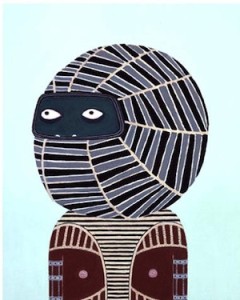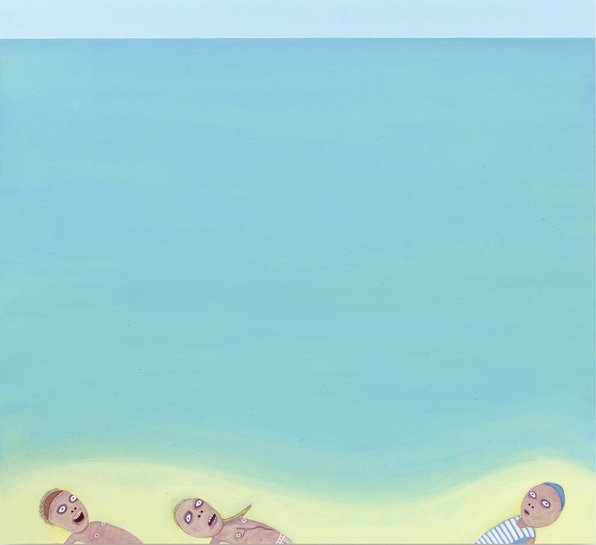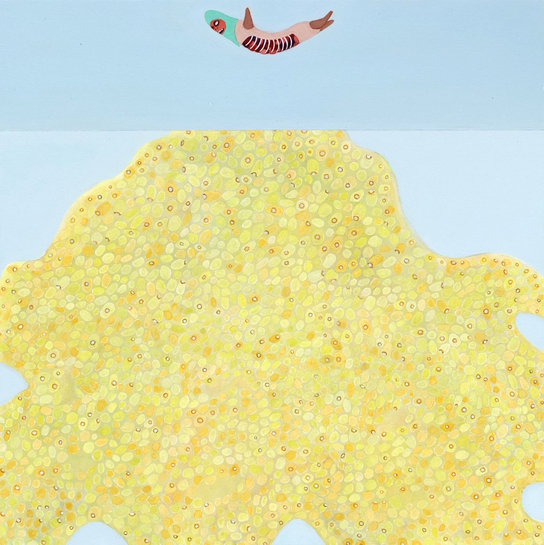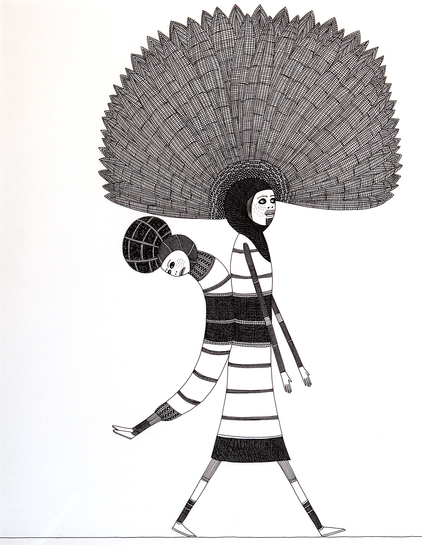
This work, ‘Untitled’ 2004, is in the collection of The Studio Museum Harlem.
About:
 Untitled (Land), 2014.
Untitled (Land), 2014.
Laylah Ali was born in Buffalo, New York in 1968 and lives and works in Williamstown, Massachusetts.
1.
Ali’s figures ask that viewers supply their own stories in response to questions of race, class, gender, and power they raise. The issue of race has long had a presence in the artist’s oeuvre, though it has moved from allegories of race relations in America to an all-encompassing investigation through outrageously hybridized figures, presenting characteristics derived from both Western and non-Western cultures. While ambiguous in reference to a particular origin or circumstance, her work comes to bear on instances of ethnic and sectarian identity — and violence predicated on such affiliations – throughout the world.
 Untitled (Sea), 2014.
Untitled (Sea), 2014.
2.
Certainly being African American or having brown skin is one lens that I look at things through. But I don’t think I have a very idealistic idea of the future.” She describes her work as conflating past, present and future. “You could be looking at something that was referring to history or it could be projecting forward into the future, but it all relies very much on my present,” Ali says.
 Untitled (Sky), 2014.
Untitled (Sky), 2014.
Though she doesn’t own a television, Ali says she was influenced by a childhood spent in front of the tube. “Watching things on a rectangular screen 15 years of your life influences how you frame things, especially when you’re thinking about telling stories. I have a daughter now and I have my eye on what could be watched, but I have to say it all just looks really boring. Everything looks so similar and commercial, like items that could be bought almost immediately.” As a child in the ’70s, she was obsessed with the hand-drawn Saturday morning cartoons of the time (“I liked the mainstream, crappy ones like Scooby-Doo and the early Warner Bros. cartoons — back when they were still kind of scary.”), but has resisted suggestions that she animate her work. “I’m attached to quiet and stillness,” Ali says.
Indeed, Ali’s simple line drawings sometimes look as if they were lonely panels from a comic book, or cartoons begging for captions. “In absence, you create a space for the viewer to verbalize, to say their own words,” she says. “Even if they’re words that don’t make sense or are inappropriate.” After all, gray area, Ali says, makes fertile ground for creating. “I know the silly side of art, and I know the serious side of art,” Ali says. “But I think there’s a lot that happens in the middle.”
(quotes from article of Gary Pini in Paper Magazine, November 2013)
 Untitled (Typology Series), 2005.
Untitled (Typology Series), 2005.
 Untitled (Typology Series), 2006-2007.
Untitled (Typology Series), 2006-2007.
3.
The precision with which Ali creates her small, figurative, gouache paintings on paper is such that it takes her many months to complete a single work. Her most famous and longest-running series of paintings depict brown-skinned and gender-neutral Greenheads and have been included in the Venice Biennale (2003), and the Whitney Biennial (2004) and were the subject of a major touring exhibition in 2012-2013 that originated at the Williams College Museum of Art, Williamstown, MA and traveled to the Weisman Museum, University of Minnesota, Minneapolis, MN and the Herbert F. Johnson Museum, Cornell University, Ithaca, NY. Ali’s works are included in the permanent collections of numerous public institutions, including the Albright-Knox Art Gallery, Buffalo, NY; the Museum of Contemporary Art Chicago, IL; the Museum of Modern Art, New York, NY; and the Walker Art Center, Minneapolis, MN, among many others.
Laylah Ali’s March 2015 exhibition at Paul Kasmin Gallery will debut a new series of characters and narratives, in development since 2011.(text website Paul Kasmin Gallery)
Courtesy: Paul Kasmin Gallery New York.
